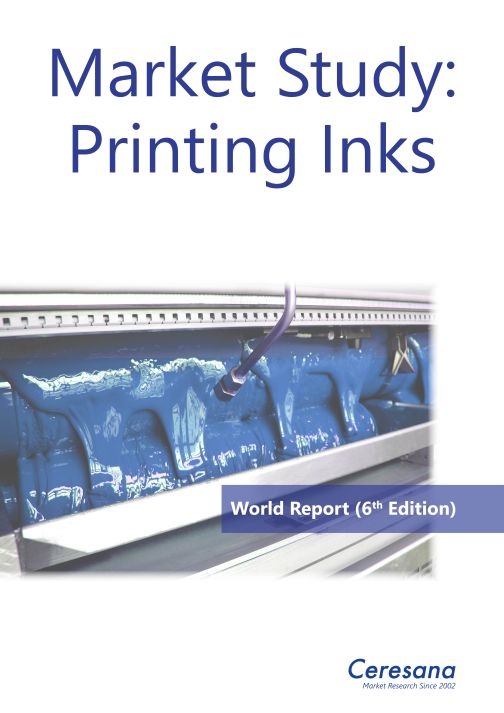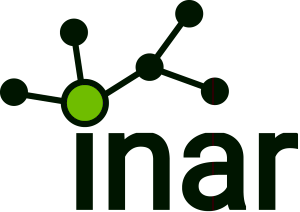Are young people returning to printed books, or at least to books-on-demand or photo books? In any case, the decline in this sector of the printing industry is slowing down. By contrast, the slump in magazine printing and newspaper printing has even accelerated since last year: The migration of readers and advertising customers to digital worlds is probably unstoppable. The latest edition of Ceresana’s global printing inks market report shows opposing trends: Publication printing continues to decrease, including the printing of advertising brochures and catalogs. However, demand for other print products is increasing. Despite trade wars and disrupted supply chains, growing consumption, particularly in the emerging markets, is driving packaging printing, for example of labels. Not only packaging of all kinds is printed, but also products such as decorative papers and textiles. Market researchers at Ceresana forecast that global demand for printing inks will increase by an average of 0.9% annually until 2034. The various regions of the world, areas of application, and printing processes are expected to develop very differently.
Opportunities and Challenges for Printing Inks
E-commerce and the packaging boom are driving demand for shipping packaging made of flexible plastics and corrugated cardboard in particular, but also for shrink labels, shrink sleeves, aseptic packaging, beverage packaging, and specially coated packaging paper. With smaller batches and more frequent redesigns, the number of print jobs grows, while at the same time print runs decrease as product variants increase. In addition to the “explosion” of SKU identification codes, government regulations and increasingly stringent traceability requirements are accelerating the need for functional and variable printing solutions. Flexographic and inkjet printing processes in particular are benefiting from the fact that flexibility and individualization are becoming more and more important. UV flexographic printing and high-speed inkjet offer a technology upgrade, for example the direct printing of 3D objects. When it comes to short runs and commercial printing such as in the office sector, digital printing with electrophotography is also showing solid growth. Offset is generally suffering from the decline of publication printing. However, UV offset printing opens up new applications, such as folding boxes or plastic films. The packaging market is very heterogeneous. In the printing ink market study, country-specific particularities are therefore outlined in individual country profiles for the most important countries.
Green Printing with Bio-Based Printing Inks
The use of energy-saving and more environmentally friendly printing processes is increasing significantly. VOC-free products that do not release any volatile organic compounds, i.e. water-based printing inks and radiation-curing UV printing inks, benefit in particular from the increasingly strict labeling requirements and regulations for chemicals and food contact materials. Bio-based printing inks do not release any toxic heavy metals. A reduced mineral oil content is not only beneficial for recycling or composting paper packaging. Bio-based solvents are at least partially made from renewable raw materials such as vegetable oils or alcohols. On the other hand, the trend towards environmental friendliness can reduce the amount of ink required, for example because packaging materials are saved and ink layers become thinner or areas remain completely unprinted. Ceresana’s current market overview provides concrete printing inks market data, e.g. figures on the individual printing ink types. For example, global demand for inkjet printing inks in the packaging printing segment is expected to grow by more than 11% per year.
Current Global Printing Inks Market Report:
Chapter 1 provides all important key figures for the global printing inks market, including forecasts up to 2034: For each region of the world, data on production, demand, and revenues are given. Revenues are given in billion US dollars and billion euros, all other figures are given in 1,000 tonnes. The demand for printing inks is broken down by relevant subcategories, including the analysis of various application areas, printing processes, and packaging types. For 7 application areas, the revenues generated with and the demand for printing inks are broken down: books, magazines, newspaper, advertising and catalogs, labels, packaging, other applications. The demand for printing inks is also analyzed according to 8 printing processes (web offset heatset, web offset coldset, sheetfed offset, flexo, gravure, other analog printing, inkjet, electrophotography), according to 6 ink types (oil-based, e.g. linseed oil inks, water-based, e.g. latex inks, solvent-based, e.g. PVB inks, radiation-curing, e.g. UV LED inks, toner, other printing inks) and according to 6 packaging types (rigid and flexible plastic packaging, packaging papers, folding cartons, corrugated board, other packaging). The demand for printing inks in each of the seven application areas mentioned is shown separately for all eight printing processes. This makes it possible to see at a glance, for example, how high the demand for flexographic printing inks is in the “packaging” sector or the demand for coldset inks in the “newspaper” sector.
In Chapter 2, the 17 most important national markets for printing inks are examined in detail. For each country, comprehensive data on production, import, export, demand, and revenues are given. The demand is subdivided according to application areas, printing processes, and printing ink types. In addition, the demand per printing process is split by the individual application areas (e.g. demand for inkjet printing inks in the “packaging” segment). Sales are also broken down into application areas.
Chapter 3 provides company profiles of the most important printing inks manufacturers – clearly arranged according to contact details, revenues, net income, product range, production sites, and profile summary. Detailed profiles of 40 printing ink manufacturers are supplied, such as ALTANA AG, Avient Corporation, Avery Dennison Corporation, DuPont de Nemours, Inc., Fujifilm Holdings Corp., Kao Corporation, and International Paper Company.
Further information about the 6th edition of the market study “Printing Inks – World”: https://ceresana.com/en/produkt/printing-inks-market-report-world

About Ceresana
As one of the world’s leading market research institutes, Ceresana specializes in the chemicals, plastics, packaging, and industrial goods sectors. Special focus areas are bio-economy and automotive / mobility. Companies have been benefiting from our high-quality industry analyses and forecasts since 2002. More than 250 market studies provide more than 10,000 customers around the world with the knowledge base for their sustainable success. Learn more about Ceresana at www.ceresana.com/en
Let’s meet! The new Ceresana event series on the future of the bioeconomy continues. Register now for the online event „Future of BioBuilding“ on December 10th and 11th, 2025. „Future of BioCoatings“ and „Future of BioAdhesives“ will follow starting in January 2026: https://ceresana.com/events
Ceresana
Mainaustrasse 34
78464 Konstanz
Germany
Press Contact: Martin Ebner, m.ebner@ceresana.com
